#colma california city of the dead
Text
#Colma: La auténtica ciudad de la Muerte#la ciudad donde residen más muertos que vivos#la auténtica ciudad de los muertos#La ciudad californiana donde hay mil muertos por cada vivo#Colma#la ciudad donde duermen los muertos#la ciudad de los muertos#cementerios famosos de estados unidos#la ciudad de los cementerios en estados unidos#la sorprendente ciudad de los muertos en Estados Unidos#colma california city of the dead
1 note
·
View note
Text
Yk if you’re interested in cemeteries n stuff I recommend doing some research and visiting this place called Colma in California
I don’t live too far from there and I drive by there sometimes it’s a gorgeous place. Colma is known as the “cemetery city” and things like that because there’s more dead people and alive which I find really interesting
I dont know why I’m sharing this but I feel like you guys should know if you have the opportunity to bc it’s a beautiful place especially if you like seeing graves in fog and in dark places
5 notes
·
View notes
Text
Welcome to Necropolis!
Incorporated in 1924, the city of Colma actually has a lot more dead residents, an estimated two million, then it does living, around 1,200. There are seventeen cemeteries within the city’s two square miles, accounting for approximately 73 percent of the total acreage of the town. Some of the boneyards contain some fairly noteworthy former folks, such as denim pioneer Levi Strauss, publishing potentate William Randolph Hearst, and Tombstone gunslinger Wyatt Earp.
So just how did this city end up with so many dead occupants? The Colma official Web site, www.colma.ca.gov/briefhis.html, tells the story colorfully, if not always with the best grammar.
A California State Law was passed in the late 1800′s, State Penal Code 297 stated-prohibited any burials anywhere except an established cemetery such as one by a city or county, church, ethnic group or military. You could no longer bury a body on the homestead or along a wagon trail.
San Francisco had many cemeteries established by the time gold was discovered. Hundreds of thousands arrived bringing diseases, followed by deaths and filled their cemeteries to capacity.
Cemetery owners started looking for new locations to expand or relocate their burial grounds. They were frustrated in their attempt to buy San Francisco property. Land was too valuable for cemetery to use said real estate promoters.
The San Francisco City Fathers passed Bill #54 & Ordinance #25 on 3-26-1900 stating that no further burials will be allowed in the City & County of San Francisco. With no further burials, they became a place of neglect and vandalism. They then became a health hazard.
Colma became the chosen area for cemeteries. . . .
In August of 1912 the San Francisco’s Board of Supervisors declared intent to evict all cemeteries in their jurisdiction.
On Jan. 14, 1914 Removal notices were sent to all cemeteries, branding them as “A public nuisance and a menace and detriment to the health and welfare of city dwellers.” Ordinance 2597.
There were many delays to this order as the cemeteries and some citizens fought to have it revoked. By Nov. of 1937 the legal battles were over and bodies not removed were now ordered to have removed.
Colma cemeteries now inherited hundreds of thousands of additional bodies.
This led to the incorporation of the cemetery area that became known as Lawndale on August 5, 1924. . . . We kept Lawndale until the United States Postal Service informed us there was a Lawndale in Southern Calif. We went back to the name of Colma. This was on Nov. 17, 1941.
City of the Dead
I live here in San Francisco and wanted to write to you about the city of Colma. It is often called the City of the Dead due to the fact that it has many cemeteries, which include Jewish cemetery, Chinese cemetery, pet cemetery, and so forth. It is known that this town has more dead people than living. The reason there are so many cemeteries is because in San Francisco it is “not allowed” to bury people. Some kind of ordinance that passed in the early 1900′s I think. You should check it out. -Leticia
1 note
·
View note
Text
There is a "cemetery town" in California named Colma. Concerns about the public health, crime, and the need for space forced the city of San Francisco to outlaw burials in 1902. The city of Colma, which is five miles south of San Francisco, was established to bury the dead. The ratio of dead to living people is 750 to 1
0 notes
Text
Random Facts
On September 18 2017, Ben Tetzlaff, a 17-year-old from Pennsylvania, recorded two holes-in-one during the same round of golf at Iron Country Club- beating odds of 67 million to one.
The Chinese city of Xi’an has created a special path designed for “phubbers”-people who walk while staring at their phones.
The town of Colma, California, outside of San Francisco, has more dead people than living people. The population of the dead is speculated to be around 1.5 million, outnumbering the living almost 1,000 to 1.
The beach on Budelli, a tiny Italian island in the Mediterranean Sea, has pink sand thanks to the presence of crushed coral, crystals, and the skeletons of dead shrimp.
The average January temperature in the Siberian village of Oymyakon is -50°C (-58°F). It was so cold in January 2018 that the village’s thermometer broke after recording -62°C (-80°F).
#daily facts#did you know#interesting stuff#random facts#seriously#are you kidding me#no way#cool facts#i learned something today#fascinating
0 notes
Text
Answer to In which place in the world is it most likely not to be alive? by Luise
Answer to In which place in the world is it most likely not to be alive? by Luise https://www.quora.com/In-which-place-in-the-world-is-it-most-likely-not-to-be-alive/answer/Luise-72?ch=15&oid=406930537&share=c7638b62&srid=7KVRc&target_type=answer
0 notes
Text
Adventures in the Bay of Slumber, Session 0
Nuria does not have a Vox Phantasma. To have a Vox Phantasma is to weaken a dream monarch and Nuria cannot afford that. To give and give pieces of themself generation after generation and for what?
Fleeting glimpses to a waking world which only disappoints? A chain of selfish fools who manipulate and overreach? Or worse, Tony Simos’ long tempered, iron hearted revenge?
No, there is no Vox Phantasma in San Francisco.
-
The dragon of San Francisco does not look like a dragon. It has not looked like a dragon in years.
Even if he wanted to—which is a matter he tries not to dwell on—he cannot. It is taken out of his hands, for claws they are no more. It is not safe and, moreover, he no longer has the power to do so.
His hoard has been diminished, as many of his clutch mates’ hoards were, his fellow dragons made vulnerable in order to strike them down. But his was done intentionally, a self-pruning of sorts, meant to preserve the core and make himself a smaller, leaner target.
It worked, fortunately…
… and, unfortunately, it continued to work.
-
The San Francisco Bay Area is nominally comprised of the nine counties bordering the water. Seven bridges cross, a not so delicate lattice of metal, industry, and traffic inspired frustration. Over a hundred municipalities, nearly seven thousand square miles, and almost eight million people—reported, at least.
Can you hear one voice?
-
Nod’s domain corresponds to a waking world whose natural disasters call for preparation and endurance: hurricanes and blizzards, in which people hunker down and wait for the storm to pass.
The waking equivalent to Nuria’s domain is plagued by earthquakes and fires, ravaging everything, leaving only rubble and ash. And yet, the people return and rebuild, a cycle of rebirth.
The aftermath of Null is not so different.
Adventurers, go forth! Revive the fallen Nuria!
~
A/N: Watch this author’s note be longer than the ficlet… but basically, I watched Dimension 20’s Unsleeping City Chapter II in which the SF Bay Area’s equivalent is mentioned. Aka, the Bay of Slumber.
Being native to California, but arguably newish to the Bay Area, I don’t have as much deep seated love/understanding/metaphorical roots as Brennan and the D20 team have for New York but I feel a little desire to… not defend the Bay Area, necessarily, but to imagine a slight tweaking where things are not so bleak as it seems.
Spoilers for that season of D20, though there’s a little bit of spoilers in the ficlet already so…
Given there is no Vox Phantasma or Vox Populi in SF, that does put it at an arguable disadvantage to NYC. However, frequently there aren’t both or either in NYC either—before Kingston was chosen, Heather Simos had been dead/taken for several years already. In that gap, the dragon of Bleecker Street was strong enough to hold down the fort and even pave the way for Kingston while actively dying.
So I figure, ok no voxes in SF; Nuria doesn’t have a tiny back up in a mortal being. But maybe a dragon can keep things stable enough to assemble a group of adventurers to find and revive Nuria.
And, optimistically, Nuria got barfed out by Null and reappeared where they disappeared (ie SF) which is why its not followed up in the season since… mega off-screen for all intents and purposes… but they were getting hit by the Iron Heart monks while holding off Null so their health is a little up in the air.
I do think dream monarchs can’t actually die, however, their sentient manifestation fluctuates based on how powerful their domain is versus more active magical strength.
Anyway, to backtrack. I reasoned that in order for SF’s dragon to not have been ganked by Null while still incorporating the canon that Gladiator fully triumphed in the Bay of Slumber, the dragon would have to somehow slip under Null’s radar. Hence pruning their hoard and getting stuck that way.
Don’t really know what to do with the lack of Vox Populi equivalent, tbh… but maybe that’s something that an actual campaign run in this would address.
Anyway, here’s a few characters that I thought would be cool to incorporate: One of the SF Shen sorcerer cousins. A monk who either survived the Iron Heart “massacre” and has to wrestle with the morals of their teachings or one whose monastery had been pushed out/poached by Tony Simos. A necromancer from Colma (aka, the city where there are more dead than living.)
That’s it.
#jacksgreyson#writing#brainstorm#fanfiction#adventures in the bay of slumber#dimension 20#the unsleeping city#the unsleeping city: chapter ii#nuria#null#Dungeons and Dragons
18 notes
·
View notes
Photo

“Offerings to the Dead” (from the collection of the Bancroft Library). An unknown photographer reputedly took the above photo (from the Bancroft Library) of what some commentators have stated was a “burial” on Laurel Hill in San Francisco, California, in 1892. As no actual burial appears in the scene, the caption for the photo may more accurately have captured the observance of Qingming by Chinese San Franciscans with attending onlookers.
Qingming, Legacy Cemeteries, and Chinese American Funeral Processions over the Centuries
The Chinese pioneers to North America brought with them their observance of Qingming (清明节), also known in English as “Tomb-Sweeping Day”(掃墳節). Qingming falls on the first day of the fifth solar term of the lunar calendar, usually the 15th day after the Spring Equinox, which can either be 4, 5 or 6 April in a given year.
Historian Thomas W. Chinn in his book, Bridging the Pacific, described the day when families visit the tombs of their ancestors as follows:
“The pure brightness Festival (Ching Ming) is the Chinese version of Memorial Day. Visits to family tombs are a formal right in China. Because the Chinese in America were far from the family tombs of their native Villages, they would visit the local Chinese Cemetery area on this day. Various associations erected “spirit” shrines for those who had no loved ones buried in the area.
“In the San Francisco area, Ching Ming is generally celebrated on a Sunday early in April. Before World War II, Chinese could not be buried in Caucasian cemeteries, so Chinese cemeteries were established near Colma, California, South of San Francisco. Buses in carloads of Chinese would travel to Colma on Ching Ming to visit the shrines or the graves of loved ones.
“At the tomb, the elder of the family would carefully sweep the graves with willow branches to repel evil spirits. Then the family would clean and pull weeds from the grave. The final ritual involved laying cooked food in dishes before the graves for the deceased to “eat.” After a while, the roast pig, chicken, buns, and so on would be eaten as a picnic lunch at the site. Following lunch, wine would be poured on the ground, after which the remaining food was removed and taken to different families. No food was wasted.
“During the course of the ceremony the spirit offering would be made, consisting of lighted incense sticks and red candles, which, together with paper money and paper clothing (sold in certain stores in Chinatown), were burned and dust transmitted to the deceased for their comfort and needs in the spirit world. While these offerings were being burned, firecrackers were exploded to confuse evil spirits and keep them from pursuing the deceased.
These same rituals are still observed by most of the older generation of Chinese in America, although offerings of food and incense and the exploding of firecrackers are not as common today.
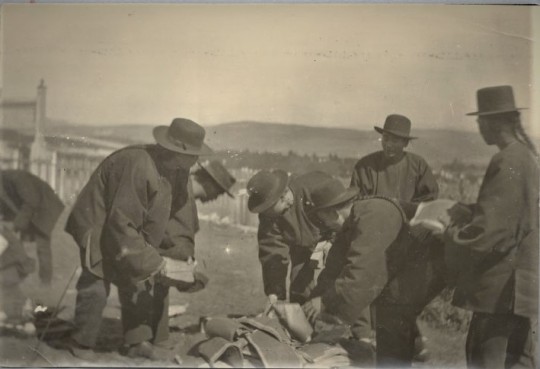
“Funeral at Gravesite,” no date. Photographer unknown (from the collection of the California Historical Society). According to Woody LaBounty of the Western Neighborhoods Project, the location was probably the San Francisco cemetery in what is now the city’s Lincoln Park and golf course. “The camera person was facing to the northeast,” according to LaBounty. “The small building visible in the photo is the caretaker's cottage of the German M. B. Society. It would take a bit of work to say which plot the photo was taken in, but it could probably be done. [This and the following image] were apparently taken only a few seconds apart.”
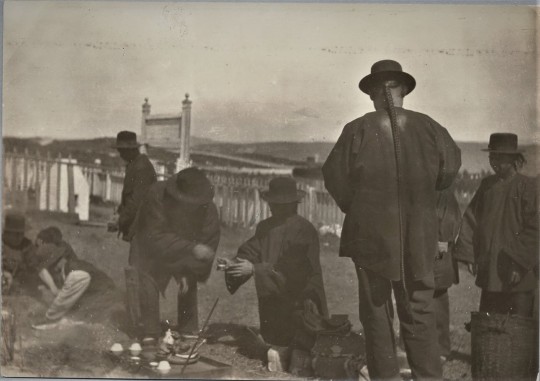
“Ceremony in a Chinese cemetery” no date. Photographer unknown (from the collection of the California Historical Society). According to Woody LaBounty of the Western Neighborhoods Project, the location was probably the San Francisco cemetery in what is now the city’s Lincoln Park and golf course.
Amidst the solemnity of the ritual offering, the absence of women from this haunting photo is palpable, as the men of the Exclusion era’s bachelor society venerate another departed pioneer of Chinese California.
When historian Thomas Chinn described Qingming as practiced by the “older generation” in 1989, he might not have foreseen its continued vitality as Chinese from the mainland, Taiwan, Hong Kong, Macau, Malaysia, Singapore, Indonesia, Thailand, Malaysia, and Singapore would continued to emigrate to the US. Wherever the diaspora calls home, they continue to celebrate the “festival” in much the same manner as the Chinese pioneers of California.

Chinese men making offerings of food, wine and incense probably in the Chinese cemetery in Colma CA. Photographer unknown (from the collection of the Bancroft Library).

A close up of the offerings placed on the funerary platform and cenotaph probably at a Chinese cemetery in Colma, CA, c. 1890 - 1900. (Photograph by Louis J. Stellman, from the collection of the California Society of Pioneers and the Bancroft Library).
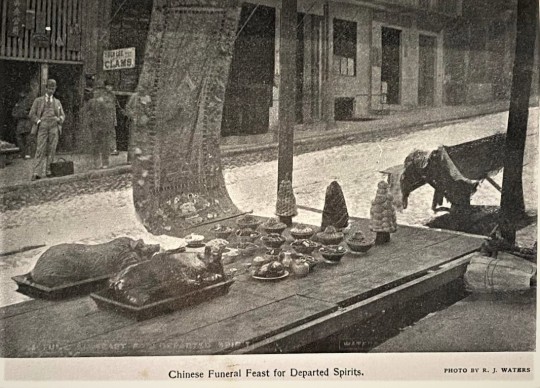
“Chinese Funeral Feast for Departed Spirits,” no date. Photograph by R.J. Waters. Local historian Art Siegel has identified the approximate location of this offering as across from Yuen Lee clam store at 719 Sacramento Street, based on a news item in the Daily Alta California of January 19, 1892:


Chinese and San Francisco’s Early Cemeteries
The annual veneration of ancestors during Qingming inevitably prompts questions about the early history of Chinese burials within the city limits of San Francisco at cemeteries such as the pioneer Yerba Buena Cemetery, Lone Mountain/Laurel Hill Cemetery, and the city’s cemetery once located on the grounds of today’s Lincoln Park. Much of the history remains obscure, but a master’s thesis by Kari L. Hervey-Lentz in 2022, titled “Remaking an Unmade Cultural Landscape: Mapping the Space and Exploring the Meaning of San Francisco’s Historical Cemeteries,” has made a major contribution to local understanding of early cemetery usage by the city’s pioneer Chinese community.
The first Chinese settlers in San Francisco community laid their deceased members to rest in Yerba Buena Cemetery. According to an early account, they occupied a separate area, distinct from the Christian burial section in Yerba Buena, which was described in one newspaper as a "strange looking place" used for the performance of their unique “genius and custom of their Pagan faith.” (J.L., 8 March 1857).
Yerba Buena Cemetery ceased burials in 1854, and the populace, including the Chinese, gravitated toward the Lone Mountain Cemetery. Newspaper accounts indicate that Chinese burials were already occurring at Lone Mountain by 1857 (citing California Farmer and Journal of Useful Sciences, 18 December 1857).

“A Chinese Funeral in Lone Mountain Cemetery, San Francisco, California,” drawn by Paul Frenzeny and published in the Harpers Weekly of January 28, 1882.
According to Hervey-Lentz, Chinese merchants in the city contributed to the construction of a receiving vault at Lone Mountain during the Fall of 1860. This vault served as a temporary resting place for prominent members of the Chinese community upon their passing, where various rituals were conducted. At its peak usage during the 1860’s, the vault held between 150 to 200 bodies at a time before their remains were repatriated to China. The Chinese community’s use of the vault proved short-lived.

“The old Chinese vault” sketch from the San Francisco Chronicle of March 25, 1888. Artist unknown.
Growing anti-Chinese sentiments forced the relocation of the interment space to the western edge of the cemetery. Hervey-Lentz’s research of contemporary news accounts from the 1880’s identified this area, now roughly bounded today by Arguello Boulevard on the west, California Street on the north, Palm Avenue [east], and Euclid Avenue (south), became the resting place for Chinese remains.In describing this relocation, one newspaper (Daily Alta California, February 8, 1877) noted the shifting circumstances, stating that the Chinese “were deprived of the privileges of interring in Laurel Hill Cemetery” and subsequently relegated to a “narrow space” near Lone Mountain. This confined area, according to Hervey-Lentz, quoting from the Daily Alta California of November 25, 1863, “likely references land on the western slope of the cemetery that the Lone Mountain Cemetery Association had granted to the Chinese Six Companies (Hop Wo Company, San [sic] Yup Company, Yong Wo Company, Sze Yup Company, Ling [sic] Yung Company, and Gin Wo Company) in 1863.

“Handsome Donation to the Chinese,” as reported in the Daily Alta California of November 25, 1863.
A newspaper article in the San Francisco Chronicle of March 25, 1888, included a sketch of the vault and mentioned that, after the Chinese community abandoned it, the structure served as a storage shed and tool shop for the cemetery groundskeepers. This information allowed for Hervey-Lentz to identify a tool shop building on a map from 1895, matching the architectural features of the vault depicted in the newspaper sketch. The structure measured approximately 40 feet in length by 24 feet in width, and there were graded pathways leading to its east-facing entrance. Notably, historical accounts indicate that Chinese funeral processions typically involved horse-drawn carts, making these pathways convenient for their ceremonies.
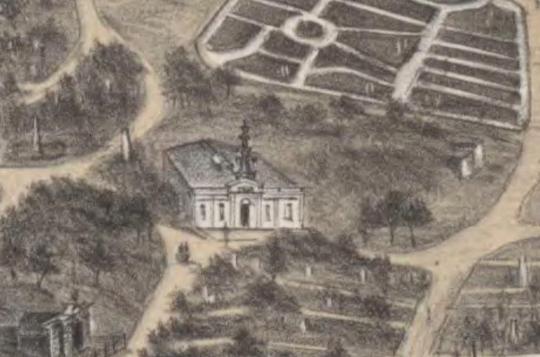
Lone Mountain Cemetery, San Francisco” c. 1866. Lithograph by Charles B. Gifford (from the collection of the Bancroft Library). The lithograph shows some of the architectural features of the central entrance, including its columns that flank two sunken panels. According to Kari Hervey-Lentz, “the structure was about 40 feet long by 24 feet wide and there would have been graded pathways that led to its east-facing entrance. . . . The structure in the 1866 image was embellished with an arched gable above the door in the Italianate style. However, Gifford identified the building as ‘other’ by drawing a fantastical and spindly pagoda on top of the structure. Although it is possible that the ornate pagoda structure was taken down before the 1885 sketch was made, the lack of other images showing this elaborate building within the cemetery coupled with the anti-Chinese sentiment of the time point towards Gifford’s 1866 embellishments as invention.”
The Chinese vault would survive into the next century. During the 1930’s, the renowned photographer Ansel Adams photographed the vault among other photos taken of the Laurel Hill Cemetery's architecture.

The entrance to the Chinese mausoleum in Laurel Hill Cemetery, San Francisco, c 1935-1936. Photograph by Ansel Adams and print prepared for his 1936 one-man exhibition at Stieglitz’s gallery An American Place—including Architecture, Early California Cemetery. Adams' photograph showcases striking architectural details of the building.
Kari Hervey-Lentz writes about Ansel Adams’ photo as follows:
“The image shows the bold architecture of the building, including an arch with sunray-like beams over the entryway. Niches with ornate arched lintels and protruding sills are captured, exactly matching the 1888 newspaper sketch. . . .Understanding that this image depicts Chinese-built architecture, and that within the architecture took place deeply meaningful spiritual and cultural practices to Chinese communities of San Francisco, provide an important context.”
Hervey-Lentz’s research about the chronology and destinations for Chinese mourners and officiants provide welcome context for the images of Chinese funeral processions of the 19th century.

Chinese Funeral Procession, Chinatown. Stockton near Pacific circa 1895 -- photographer J.S. Wooley (Courtesy of a Private Collector). This photo captured a view northwest across 1100 block of Stockton Street between Jackson and Pacific showing the west side of the street. A funeral procession with horse-drawn hearse leads mourners walking in the street. Quen Hop (or Quon Hop) underwear factory 1119 Stockton, appears in the background at right.
Jesse Brown Cook (1860-1938) served the San Francisco Police Department from the late 1880s to the 1930s. He began as a beat officer, and then served as a sergeant of the “Chinatown Squad.” He served as Chief of Police after the 1906 earthquake, retired, and was later appointed to the Police Commission. In his memoirs, Cook wrote about various aspects of the 19th century Chinese in the city and their customs, including funerary rites and the observance of the Qingming festival in the Chinese section of the cemetery out near the city’s Land’s End as follows:
“When I was a boy it was a great treat to go out to the Chinese burying grounds, now known as Lincoln Park. It was a long journey out there -- a long and a solemn one for the Chinese. The Chinese buried their dead in great state. They brought out choisest [sic] cooked foods for the dead to eat before they left the earth (the tramps and birds could be seen eating this later). As the procession moved through the cemetery they threw into the air small pieces of paper with holes. It was believed that the Devil or Evil Spirits had to pass through each little hole before reaching the spirit of the dead. Thus they could beat the Devil and get the body buried first so the Devil could not reach it.”

The few surviving cemeteries of Chinese California comprise part of the dwindling physical legacy of the Asian pioneers on the American frontier. Most Chinese were interred in segregated and often forgotten graves.

Re-touching gravesite information on markers at a Chinese cemetery (probably in Colma, CA) c. 1900. This photograph by Louis Stellman appears in Richard Dillon’s 1976 book for the Book Club of California, Images of Chinatown - Louis J. Stellman’s Chinatown Photographs.
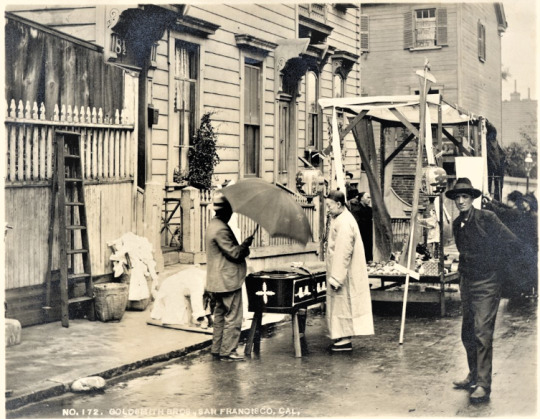
View of a casket resting on a support in a street, wagon parked beyond; several men standing nearby; Chinese funeral preparations in San Francisco, Cal. Photograph by Goldsmith Bros. (from the collection of the California State Library).
The tourist travelogues of the late 19th century expressed constant fascination with the social fabric of old San Francisco Chinatown. The quality of such accounts varies widely, ranging from the profoundly ill-informed, or even racist, to the sometimes scholarly. Tourists to pre and post-1906 Chinatown often saw funeral rites conducted in the streets and recorded their obsersations. In an article published by The Pacific Tourist in 1878, F.E. Shearer wrote about Chinese funerary practices as follows:
“The funerals are conducted with great pomp. The corpse is sometimes placed on the sidewalk, with a roast hog, and innumerable other dishes of cooked food near it, when hired mourners with white sheets about them, and two or three priests as masters of ceremony, and an orchestra of their hideous music, keep up for hours such unearthly sounds as ought to frighten away all evil spirits.
“The wagon-load of food precedes the corpse to the grave, and from it is strewn “cash,” on paper to open an easy passage to the “happy hunting grounds” of the other world.
“’Ancestral Worship’ is the most common of all worship among the Chinese. Tablets may be seen in stores, dwellings and rooms connected with temples. Its origin is shrouded in mystery. One account derives it from an attendant to a prince about 350 B.C. The prince while traveling, was about to perish from hunger, when he cut a piece of flesh from his thigh, and had it cooked for his master, and perished soon after. When the prince found the corpse of the devoted servant, he was moved to tears, and erected a tablet to his memory, and made daily offerings of incense before it. Other absurd stories of filial devotion are told for the same purpose.
“The ancestral tablet of families, varies from two to three inches in width, and 12 to 18 in height, and some are cheap and others costly. There are usually three pieces of wood, one a pedestal and two uprights, but sometimes only two pieces are used. One of the upright pieces projects forward over the other from one to three inches.
“One tablet can honor only one individual, and is worshiped for from three to five generations. To the spirit of ancestors a sacrifice of meats, vegetables, fruits, etc., is often made with magnificence and pomp, and the annual worship of ancestral dead at their tombs, is of national observance, and occurs usually in April, and always 10 days after the winter solstice. . . .
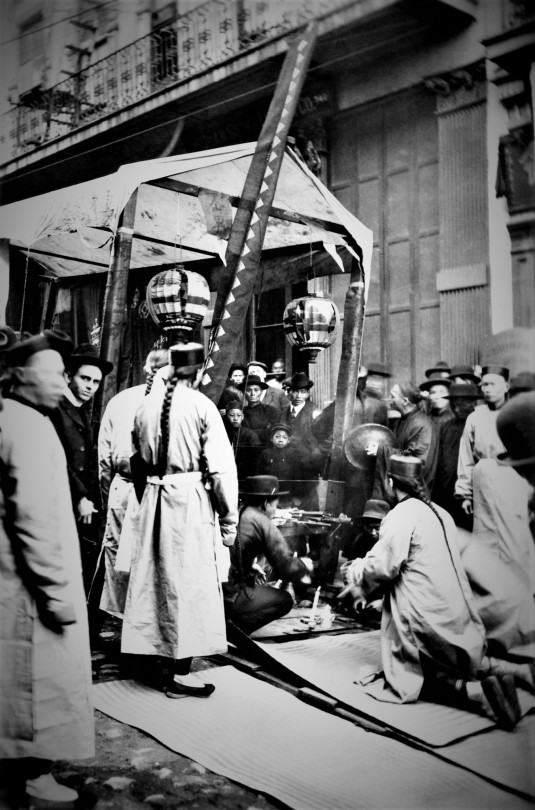
Dupont Street funeral, c. 1895. Photographer unknown (from a private collection).
“The offerings are more plentiful than the meats at a barbcue in the Far South, carcasses of swine, ducks, chickens, wagon-loads of all sorts of food and cups of tea, are deposited at the graves; fire-crackers continually exploded, and mock money and mock clothing freely consumed. All kneel and bow in turn at the grave, from the highest to the lowest.
“As in the case of the gods, the dead consume the immaterial and essential elements, and leave the coarse parts for the living. Unlike the gods, the dead consume ducks. ‘Idol no likee duck, likee pork, chicken, fruits.’”
-- from Shearer, F.E., “The Chinese in San Francisco,” The Pacific Tourist, (Henry T. Williams pub., 1878), p. 323.
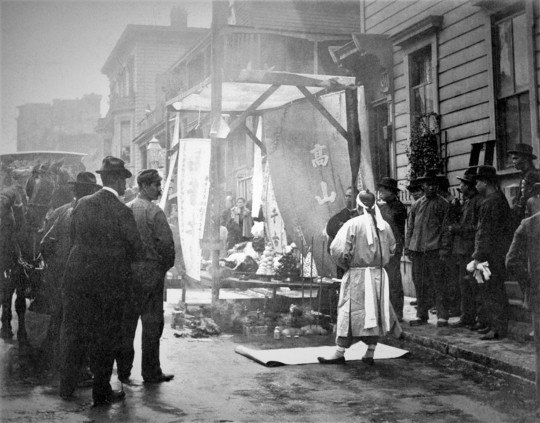
“Street Scene” of a funeral in San Francisco CA. No date. Photographer unknown (from the collection of the Bancroft Library)

A funeral parade on Dupont Street, c. 1900. Photographer unknown (from a private collection). The signage of the mercantile house, Sing Fat & Co., at 614 Dupont can be seen in the left of the photo.
As the presence of Chinese in North America lengthened, the various family and district associations assumed the responsibility for providing funeral and burial services on tracts of land devoted for Chinese use, including the construction of funerary incinerators and the appropriate positioning of grave plots according to feng shui (風水) principles.
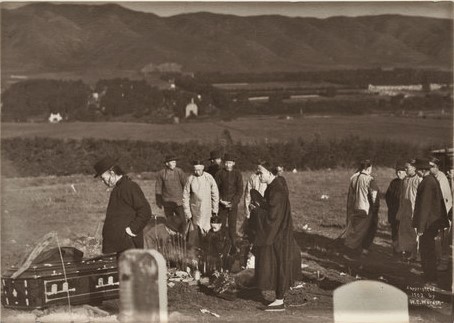
The above photo appears to depict a funeral in Colma, California, c. 1903. Photographer unknown (from the collection of the Bancroft Library). The absence of women from the photo is palpable, as the men of the Exclusion era’s bachelor society lays to rest another pioneer of Chinese California.
Away from the major settlements, however, and in the smaller towns of the Sierra foothills, the cemeteries established by small Chinese communities eventually fell into disuse and decay, as Chinese were driven off or drifted back to the cities.

A Chinese funeral procession in Dutch Flat, CA.
Today, the discovery of Chinese graves often occurs during large-scale construction projects in areas that were settled during the mid-19th century. In 2005, the construction of the Metro Gold Line Eastside Extension revealed 174 unmarked Chinese graves in Boyle Heights.
In the Boyle Heights case, the LA Times reported in 2010 that all the bones and artifacts were reinterred inside Evergreen Cemetery which had originally banned Chinese interments. About 1,400 Chinese were believed to have been buried in the Boyle Heights potter’s field. According to the Times, and despite an outreach effort, the MTA was unable to identify any living relatives of the Chinese whose remains were uncovered during the digging for the Gold Line extension.


The Chinese who helped build California were forbidden to marry or own property, and they were generally barred for decades from using the secular burial grounds that served the state’s cities and towns. Moreover, the Chinese practice of unearthing bones for shipment back to the deceased’s ancestral village (as seen in the photo below); the practice complicated the maintenance of grave markers and even the identification of the locations of Chinese graves over subsequent decades.

Bone pickers in Colma CA.

“Cleaning the Bones of the Dead” (after disinterment) from “Chinese Life in San Francisco” engraving published in Harper’s Weekly, c. 1879. Illustrator unknown.
The cemeteries of Chinese California and elsewhere in the American West represent part of the vanishing physical legacy of the Chinese pioneers in far-flung rural communities. Many have only markers to show the locations of long-deceased ancestors.

Borden CA

A Chinese cemetery in Los Angeles CA, c. 1900. The funerary burner bears the date of September 1886. Location and photographer unknown from the California Historical Society Collection at the University of Southern California.
Conventional historical accounts assert that the practice of disinterring remains for shipment back to the ancestral villages in China continued in North America at least up to the 1949 communist victory in the Chinese civil war. The growth of families in the US, however, also induced many Chinese families to bury deceased family members in permanent plots in America, presumably to facilitate veneration of ancestors in the US.
Regardless of the changes in the ultimate disposition of ancestral bones, large funeral processions continued to represent significant occurrences on the Chinatown streetscape. My great grandmother’s death in December 1922 presented a notable and exceptional example of a community-wide honor to a woman. Contrary to the news report about the family’s original intent to send her bones to China, my great grandmother’s remains were permanently located in Olivet Cemetery in Colma CA.

As the above clipping from the San Francisco Examiner of December 25, 1922, attests, the rites and funeral procession for my great grandmother Hee Ching She (erroneously named “Chuck How” in the news article), made the news for its size and hundreds of women attendees.

The all-women head of the funeral procession for Mrs. Hee Ching She in San Francisco Chinatown on December 24, 1922.

The San Francisco Examiner reported that the December 24, 1922, funeral procession for Mrs. Hee Ching She “strung along for three city blocks, the women halted first in front of the decedent’s home, 620 Clay street, then again in front of the home of the [actually younger] son, at 705 Kearny street, finally disbanding at the corner of Pine street and Grant avenue.”

The southbound funeral procession of prominent businessman Chin Bok Lain (1869 - 1938) as viewed from the balcony of the Hang Far Low restaurant overlooking Grant Avenue toward the intersection of Grant and California Street at the top of the photo. A brief account of Chin’s life by his descendant, Kenneth J. Hong, may be read here.
The acceleration of Chinese American family formation and growth because of the enactment of the War Brides Act and the Immigration Act of 1965 also strengthened the practice of permanently locating and venerating ancestral graves in communities across North America.
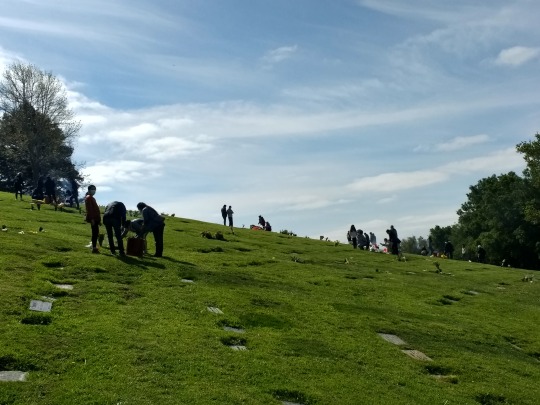
Families present offerings and burn paper money for their ancestors in the Chinese section of the Mountain View Cemetery in Oakland CA, on Qing Ming or Tomb Sweeping Festival day in 2021. (Photo by Doug Chan)
Although terrain may vary, the old rules of grave location, e.g., south to a hill or north toward water in front of the grave, and ideally with a “mountain behind and luxuriant plants around” remain desirable. Over the course of events during the 20th century, Qing Ming became, and remains, a very Chinese American day of remembrance.
[updated 2024-4-14]
#Qing Ming#Tomb Sweeping Day#Thomas W. Chinn#Chinese funerals#Chinese cemeteries#Yuen Lee clam store#Lone Mountain Cemetery#San Francisco Chinatown#Dutch Flat#Hee Ching She#Ansel Adams#Laurel Hill Cemetery#Yerba Buena Cemetery#Jesse B. Cook
6 notes
·
View notes
Link
Colma is a small incorporated town in San Mateo County, California, on the San Francisco Peninsula in the San Francisco Bay Area. The population was 1,792 at the 2010 census. The town was founded as a necropolis in 1924.
With most of Colma's land dedicated to cemeteries, the population of the dead—about 1.5 million, as of 2006—outnumbers that of the living by a ratio of nearly a thousand to one. This has led to Colma's being called "the City of the Silent" and has given rise to a humorous motto, now recorded on the city's website: "It's great to be alive in Colma".
17 notes
·
View notes
Note
Prompt: Mulder & Scully make a wrong turn on the way back from a case and end up somewhere cool.
City of Souls: fic
What a great prompt - thanks! I’ve never been to Colma so all mistakes are mine. Set late season 6, before The Unnatural.
He spits a seed outthe window and turns to her. He’d rolled his sleeves up hours ago, flung histie over the back seat. It might be the end of a California summer but the heatis unrelenting. Sweat prickles at the creases of his elbows. Immaculate in herseat, Scully’s still all business. Whole and upright.
“When was the last time you worejeans, Scully?”
She doesn’t answer. He hates thesilence.
The sign reads ‘It’s Great to Be Alive in Colma’. He waits for her reaction. Nothing.He drives. On each side there are cemeteries. She’s drinking water and lookingout at the rows of uneven headstones. Thereare hills behind them, scratched brown from too much sun. Withered. He makes amental note not look back too often.
“Scully, do you prefer Gunfight atthe OK Corral, the 1957 classic western starring Burt Lancaster and KirkDouglas or Tombstone, the 1993 remakestarring Kurt Russell and Val Kilmer?”
He hears the creak of gristle in herneck as she turns towards him. There’s a tiny kink in her lips. Upwards. He letsout a slow breath.
“I haven’t seen either, although Iunderstand the cast of each movie was stellar. Maybe you can invite me over fora classic western movie night, Mulder. We can drink beer in our Levis and talklike John Wayne or Clint Eastwood.” She’s teasing him. And his skin stipples inappreciation.
“I see you with your hair tuckedunder a Stetson riding over the plains, outrunning and outshooting the outlaws,Sherriff Scully.”
Another cemetery looms ahead. Padgett is still a fresh nightmare. Herblood-soaked shirt stayed behind his eyes for weeks, a metallic tang taintedeverything he ate. He felt empty. Hollowed out, just like the bloodied chestsof the victims. Life scooped from them. Ribs yawed open, bones like gravestonesin rows. When she is quiet, he still feels empty.
He blinks away the image and turns to her. She relaxes into a smile,plays with a strand of that glorious hair. Now, he sees autumn sun, tastes theburnt edges of pumpkins, feels in his limbs the strange looseness of holidaysto come.
“Maybe we can spin our guns or crack our whips?” She’s still playing thegame and his heart thrums. And then she laughs. God, he loves that sound. Likethe pop of a vintage champagne cork, a surprise followed by perfection.“Mulder, why have we driven so many miles in the wrong direction?”
There’s another sign. Arrows to the town mall and the primary school andthe Cypress Lawn – Nobel Chapel. He turns towards the chapel.
“This is the City of Souls, Scully. Colma. Population 1500 livingresidents and 1.5 million souls. In1900, the city of San Francisco declared the land in the town too valuable forburying the dead. In 1914, they sent eviction notices to all the cemeteriesordering the dead to be removed and relocated. Colma was chosen as the ‘end ofthe line’ so to speak. And now there are 16 cemeteries here, including a petcemetery.”
She leans towards him, adjusts her seatbelt. She’s still holding on tothat smile. But he’s holding on to it tighter. Her cheeks are pink. “But whyare we here?”
He doesn’t tell her he feels like he’s lost his soul and in some improbableway he imagines that staying here will fill him up with new life, will give himback some of what he’s given away this year. Just like that psychic surgeonstealing away people’s beating hearts, Diana has sucked the very core out ofhim with her unending support and her sly smiles. He feels her grip chafing athim, marking his skin so that Scully sees betrayal like a scarlet letter. Hedoesn’t tell her anything like that, although he should. He should declare hisguilt to her so she can flog him with her righteousness. He doesn’t tell her,though.
“Haven’t you ever wanted to see where Joe DiMaggio is buried? Or Frank‘the crow’ Crosetti? Wyatt Earp? Levi Strauss?” Her fingers rub across herplump lips. “I see you aren’t quite as into this as I am,” he says and shebestows a gentle shake of her head on him, one that’s accompanied by a quietchuckle.
“I can’t say I am, Mulder but if you feel that visiting the graves offamous sports people or cowboys, is something you need to do, then knockyourself out. I’ll be happy with a cold beer and a steak. I’m hungry. And thistown is making me crave dead meat.”
He laughs then. She’s funny, his Scully. She metes out her jokes inincrements, measuring out the time between each beat so it’s not too long, nottoo short. She’s good with her timing, like that. Knows just when to step in, whento step back. He hasn’t learnt that yet. But this business with Diana hastaught him that jumping in blindly, just for support of some kind, is not whathe wants anymore. Not what he needs.
He turns into the cemetery, feels a shift in the air. It’s not mournful.There’s something serene about it, a quiet calm. It’s in the cooling of theharsh sun, it’s in the shush of the leaves, it’s in the melodic birdsong. Thedead enjoy the longest rest, but the living can come here and reset.
She’s out of the car before him, shucking off her jacket and shieldingher eyes from the lowering glare. California Scully is brighter in every way,he decides. Kaleidoscopic despite her penchant for black work-wear. Everythingelse about her is a melange of soft colours. He takes her in.
“Walk with me?” she asks and offers an elbow for him to hook his armthrough. He wonders if she understands the irony of promenading around acemetery while the dead lie still beneath them. He’s sure she does, but Scullydoesn’t mind irony. She doesn’t like duplicity. She just doesn’t like beingtaken for granted.
He watches their shadows pass the headstones, long thin versions ofthemselves stretching out in some ghoulish representation of life. He needs tolook back at her, see the tangible partner on his arm.
He tips his chin towards her. “Those who couldn’t pay the $10 evictionand relocation fee left their loved ones to be piled into mass graves.”
“It’s a cruel and undignified story,” she replies. “But death is oftenugly.”
Her shirt was wicking bright red as quickly as her skin paled. Hehesitated because in that moment he was sure she was gone, and he had let ithappen. His fucking arrogance had led her to the terror of a death like that.Her beating heart stolen from its hearth right there in his own home.
The warm surprise of her fingers clasping through his shook the pictureaway, dissolving the stark of red death into the muted tones of Scully’ssmiling face. She nods to a plaque on a large sculpted rock. He reads thedetails.
“When you were in that travel agency, with Duane Barry, I used thisman’s case to highlight the potentially dangerous misreading of the situation.It’s one of the clearest memories I have of that time.”
He takes in the information as she speaks.
“The Gage Accident. Phineas Gage was working on the railroad at Vermontwhen a tamping iron blasted upwards and pierced his skull from cheekbone totop.” She touches the spots on her own face and he watches the grace of herfingers. “Miraculously, he survived but his behaviour changed so much that hewas no longer the same man.”
It might not have taken an industrial accident to change him, butScully’s ferocious charge for justice, right by his side, has been just as redhot. She has stayed on the same damned path, never deviating, while he’spinballed from belief to doubt and all the while dragging her along with him.Exposing her to horrors. How has she remained the same? Fuck, he loves her forit. He loves her sameness, her unwavering Scully-ness. You know what you’regetting. You get what you see.
“I remember you talking about him,” he says. “I thought it would be goodto see the memorial. And we really weren’t that far away. It seemed the rightthing to do.”
She tucks her chin to her chest. “Well, it’s a very ‘us’ kind of thingto do, isn’t it? It’s a graveyard. It’s macabre. I’m only surprised that it’snot raining. It would be just the kind of after-case date we would indulge in.”She looks away quickly, licks her lips. “If this were a date.” The words arebreathed out, low.
He looks around at the graves, thinks about the dead beneath them, lyingsilent in repose. Souls departed, bodies left behind. Bones desiccating toashes. He thinks about Phineas Gage and Levi Strauss and Jo DiMaggio, how theirlives are still known. He looks back at Scully and she’s waiting for him tospeak. He can’t find any words to tell her how much he wants her life to beknown for centuries to come. There’s a glint of sunlight off the brass of theplaque and he squints as it flashes in his face. He shivers but lets the sensationwarm him, like heat from the inside, filling him.
“There’s a 50s style diner not far away,” he says, looking back at her face, where he sees hope, forgiveness and he feels his soul settle back inside. “Let’s get that steak, Scully.”
128 notes
·
View notes
Text
The 3 Ps Assessment: Parties, Political Interest Groups, and PACs
1a. Republican: Restrictions on energy is taking thousands of jobs and hurting the American economy. We nee to use our own oil, “clean coal”, natural gas, solar, geothermal, and nuclear energy to relieve our dependence on Middle east oil.
Democrat: America should be running on clean energy by the mid-centry. American states are already seeing an increase in hurricanes, droughts, and flooding. The need for clean energy means there’s a need for new jobs to work for clean energy companies instead of big oil.
Libertarian: Governments shouldn’t be subsidizing any form of energy and they have a terrible track record with the environment, so they aren’t responsible for it. We shouldn’t trust governments with out environment and energy resources.
Green: Climate change is the largest threat facing America and the world today. They want to cut 95% of greenhouse gas emissions by 2050. They want to encourage and create clean energy jobs. They want a strong international climate treaty. They want an economic policy for a safer climate treaty. They want clean agriculture.
Peace and freedom:They believe that socialism is necessary to end the destructiveness of capitalism on our environment. They want to out-law unsustainable practices such as clear cutting and fracking. They want free public transportation, and to eliminate nuclear power plants. They want to restore the damage in our air and water systems. They also want to end environmental racism.
1b. Republican: I agree that we need to relieve our dependence on oil from the Middle East, but we don’t have the same reserves as them. We don’t have enough oil in the U.S to support how much we use. We need to be relieving dependence on all oil, natural gas, and coal. And focus on solar energy.
Democrat: I agree with almost everything the democratic party said about climate change. But their predictions aren’t realistic. Scientists say we’re not doing nearly enough to keep “global temperature increases to “well below” two degrees Celsius and to pursue efforts to limit global temperature increases to 1.5 degrees Celsius.”(as agreed in the Paris agreement). To do this we need to lower our meat consumption greatly, but it doesn’t state that as ways we can lower our CO2 and methane emissions.
Libertarian:I agree the the government has a bad tech record with the environment, but in dire times the government should take control and restrict certain things to ensure public safety and health for generations to come.
Green: I agree with all of the libertarians points. I don’t know that they’re reachable, but they do include the effects of animal agriculture. they want to encourage less meat consumption, and promote organic and local food production and distribution.
Peace and freedom: I agree with everything that peace and freedom says. Sadly, this is the only way we can really stop climate change, and ensure life on earth for the human race.
1c. I agreed most with the Peace and Freedom’s platform. This doesn’t surprise me too much because although they're views are extreme, we need an extreme and radical change to combat climate change.
2a. Sierra Club
2b. "The purposes of the Sierra Club are to explore, enjoy, and protect the wild places of the earth; to practice and promote the responsible use of the earth's ecosystems and resources; to educate and enlist humanity to protect and restore the quality of the natural and human environment; and to use all lawful means to carry out these objectives."
2c. 1. Protect wild places and endangered species
2. Keep our air and water clean
3. Ensure a clean energy future
4. Curb climate change
5. Keep the pressure on politicians and corporations to ensure safe and healthy communities
2d. The Sierra Club endorses the legislation 1631 that “holds polluters accountable by investing in projects that will lead to cleaner air, cleaner water, and a healthier future for Washington.”
2e. There are Sierra Clubs located around the nation, but there are local ones in Oakland and Berkely. On October 27, there’s a “ walk through the city of the dead” at the Colma BART station. On October 29 there’s a “speak up for SF’s resolution supporting the bay-delta protection plan” in San Francisco city hall. There’s the “West Contra Costa monthly group meeting” on November 3 in Berkely.
2f. Yes there are volunteer opportunities including planting trees, canvassing, and attending hikes.
3a. California Environmental Justice Alliance
3b. "The California Environmental Justice Alliance is a statewide, community-led alliance that works to achieve environmental justice by advancing policy solutions. We unite the powerful local organizing of our members in the communities most impacted by environmental hazards- low-income communities and communities of color- to create comprehensive opportunities for change at a statewide level. We build the power of communities across California to create policies that will alleviate poverty and pollution. Together, we are growing the statewide movement for environmental health and social justice."
3c.1. Replacing big polluting industries with a green, locally based and sustainable economy
2. People’s lives and health are more important than big business profit
3. Working to have no barriers to opportunity for low-income communities and communities of color.
4. Working to have no discrimination in state policies and practices.
5. Working to relay only on clean energy and eliminate toxic industries that pollute our water, land, and health.
3d. The CEJA endorses AB 523 by Assemblymember Reyes to expand access to clean energy in California.This will help break down barriers that don’t allow low income communities to have affordable access to clean energy.
3e. They’re located on Oakland. I did not find any local meeting I could attend.
3f. Yes you can volunteer to send a pre-written email to governor Brown asking him sign AB 523.
4. Both the Sierra Club and the CEJA seemed pretty organized, but the Sierra club had more opportunities to get involved and just generally more to explore on their site. The sierra Club seems more successful, partially because they have more ways to get involved on their website. The Sierra Club targets people around the nation that are concerned about the environment and want to get involved, while the CEJA is geared toward Californian’s who are concerned about the environment. The CEJA seemed to project more concern for the health of low-income areas, and people of color that are often not represented in environmental justice, and are at the highest health risks because of where they live and the amount of money the have (environmental racism). The CEJA’s supporters include APEN (Asian Pacific Environmental Network), CBE (Communities for a better Environment), CCAEJ ( Center for Community Action and Environmental Justice), and CAUSE ( Central Coast Alliance United for a Sustainable Economy).
5a. Koch Industries
5b. “We challenge ourselves to improve people’s lives by creating better products using fewer resources. At the same time, we challenge barriers that hinder competition, opportunity, innovation and progress.”
5c. Total receipt: $3,767,334
Spent: $3,754,267
cash on hand: $1,602,378
5d. they have given a total of $1,488,000 to candidates. 2% went to democrats, and 98% went to republicans.
5e. Some of their donors include Koch Industries, Invista Sarl, and Molex LLC. Invista makes chemicals, polymers, fabrics and fibers for clothing, carpets, and car parts. Molex LLC is a technology company that makes products such as lighting, and cables. Most of their donations come from their own company.
1 note
·
View note
Photo


Grand River Cemetery!
Lore: The United States has a handful of true necropolises. One very famous one is Colma, California, where numerous burial spaces are found. Another is Grand River Cemetery in San Cipriano. Created during a century-long period when San Cipriano law required that all burials must take place in the Franklin District beside the Grand River, the Grand River Cemetery was owned by the notorious Carpenter family dynasty (one of the city’s founding families). Wealthy families, extant and extinct alike, built huge mausoleums and crypts in the cemetery, while poorer folk were interred in every possible arrangement throughout the enormous grounds.
Grand River Cemetery is a sprawling place, easily as big as any other city neighborhood. After the Carpenter family’s grim collapse in the 1970s, the neighborhood was subdivided by would-be new operators, but most of them failed or were bought out. Today, Grand River Cemetery is a city of the dead within the bounds of San Cipriano, too tangled in old legal and financial chaos to be bulldozed and redeveloped in any but the smallest way. On its outskirts, criminals, homeless people and rebellious teenagers set up shop among the tombstones and in the old sepulchres. At night, in the deepest parts of the cemetery, no one but the supernatural and its hunters will dare set foot inside.
2 notes
·
View notes
Text
Colma, Kota di California yang Lebih Banyak Dihuni Jenazah Dibanding Orang Hidup

Sebuah kota kecil yang berada di semenanjung San Francisco, negara bagian California, Amerika Serikat, memiliki keunikan dan daya tarik yang berbeda, karena ketenangannya. Alasannya, karena kota ini lebih banyak dihuni jiwa-jiwa yang sudah mati ketimbang mereka yang masih hidup.
Sejak tahun 1912, Colma telah menjadi rumah bagi 1,5 juta orang yang telah meninggal. Jumlah tersebut berbanding terbalik dengan total penduduk yang masih hidup d isana. Dengan luas kota 2 mil persegi atau sekitar 3,2 kilometer persegi, hanya 1.700 penduduk yang tercatat tinggal di Colma.
Dilansir Oddit Central, masyarakat yang tinggal di Colma memang menghabiskan hidup dan mati mereka dikota
ini, dibanding kota metropolis yang mahal. Pada tahun 1990, San Francisco dikenal sebagai kota tempat mereka yang sudah mati.

Pada masa penambangan emas dan perdagangan, imigran dari seluruh dunia mendatangi kota ini untuk mencari kehidupan yang lebih baik. Sayangnya, mereka datang dengan membawa virus penyakit dan banyak korban berjatuhan.
Tak hanya dianggap sebagai pembawa virus penyakit, imigran juga disebut sebagai pengambil tanah, karena membuat 27 pekuburan. Karena mereka dianggap membawa virus berbahaya, pada tahun 1902, Dewan Pengawas Negara melarang melakukan penguburan lebih lanjut di dalam kota dan memaksa mereka untuk melakukan pemakaman di lahan yang lebih besar, seperti Laurel Hill dan Kalvari Cemetry.
Meski telah dilarang, para imigran tetap mempertahankan jasad yang telah dikubur di tempat asalnya. Namun, sejak 1942, hanya ada dua tempat pemakaman yang ada di San Francisco: The San Francisco National Cemetery dan Mission Dolores Cemetery.
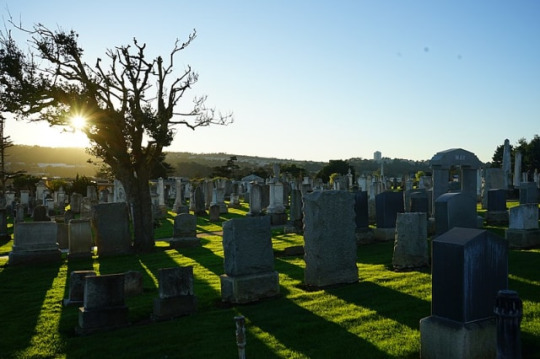
Hingga kini tempat pemakaman tersebut masih ada, hanya saja tidak menerima jasad baru untuk dikubur. Empat dekade kemudian, Uskup Patrick Riordan memutuskan untuk membuat tempat pemakaman baru di sebuah lembah yang berjarak 8 kilometer dari Colma.
Sejak saat itu, lebih dari 150 ribu mayat akhirnya dipindahkan dari San Francisco ke Colma. Kota kecil itupun diberkati dan dinobatkan sebagai satu-satunya kota di dunia, di mana jumlah orang mati lebih banyak dari pada yang hidup.
Perbandingan tersebut tak pernah berubah hingga hari ini. Sebanyak 1,5 juta orang tidur dengan abadi di sini. Diperkirakan ada 75 jenazah yang dikirimkan ke kota ini setiap harinya.
Sepanjang sejarah, Colma tidak pernah memiliki lebih banyak jumlah penduduk yang hidup dibanding yang mati. Perbandingan tersebut pun tak pernah berubah hingga saat ini.
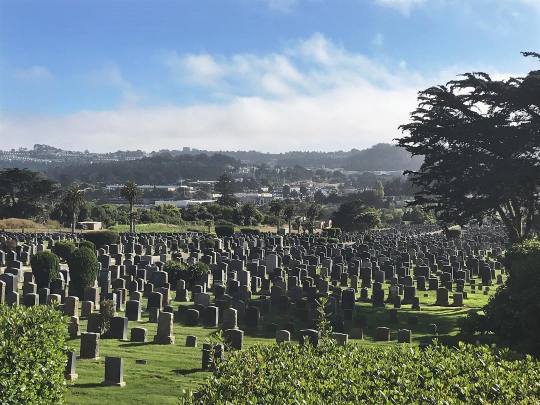
Beberapa julukan juga diberikan untuk Colma, seperti The City of the Silent, The City of Souls, atau The City of the Dead. Warga yang hidup pun tak merasa terganggu dengan keberadaan mayat-mayat ini.
Mereka tahu bahwa orang matilah yang membuat rumah mereka unik. Bahkan, mereka menggunakan sedikit humor kuburan ketika membuat slogan kota yang berbunyi, "Rasanya menyenangkan bisa hidup di Colma."
Colma juga menjadi rumah abadi bagi banyak tokoh sejarah, mulai dari penjudi legendaris Wild West, penegak hukum Wyat Earp, penemu denim Levi Strauss, hingga ikon bisbol Joe DiMaggio.
SUMBER : KUMPARAN
#colma#kota#california#mati#jenazah#city#mancanegara#international#artikel#berita#luarngeri#unik#traveling#wisata#itudewa#agenjudi#bandar judi terbesar#juditerpercaya#bandarq#bandarceme#bandardomino#bandar ceme terbaik#bandarpoker#bandarcapsa#withdraw#telkomsel#xl#omaha#blackjack#superten
0 notes
Text
Town Of The Dead: Colma, California
Did you know there is a town in California full of dead people?
Colma is a small incorporated town in San Mateo County, in the San Francisco Bay Area that was actually founded as a necropolis in 1924.
The population of living folk was a mere 1,792 at the 2010 census.
But with most of the town’s land dedicated to cemeteries, the population of the dead—about 1.5 million—outnumbers that of the…
View On WordPress
1 note
·
View note
Photo

Colma, California February 2017
Fun fact: With most of Colma's land dedicated to cemeteries, the population of the dead outnumbers the living by over a thousand to one. This has led to Colma's being called "the City of the Silent"
#colma#california#travel#travel ideas#photography#city of the dead#city of the silent#cemetery#graves#photography blog#travel blog#fun fact#elisa shoots#rainy days#rain#rain window#dead city
0 notes
Link
Each place in this world is separately significant and unusually unique. Every city, All towns, and Each site has some characteristics that make it one of its kind. What have you heard the maximum that is the epitome of weird? There is a town where you can’t die formally. There is a town which is shared by two countries in the same landscape. There is a town themed totally as hell on this heavenly earth. This article is the carrier of such eight extensively weird cities in the world with their unusual and never-heard unbelievable concepts to make you bizarre!
The Slab, Free City in America
Officially known as the Slab city, it nestles in the Californian state of America. The town is very much unusual as there is no presence of amenities. The population in this town mainly constitutes the retired people, vagrants, or people who have no place to anywhere else in the world. They live in the ramshackle wooden huts called shanties in the absence of basics like water and electricity. They also have no particular addresses that mention their exact stay location. The town is inconveniently convenient for the people who live there and name it ‘The Last Free City of America.’
A town in caves
The Matmata town is in the Djebel Dahar region of South Tunisia that is in the troglodyte style village arrangement. There plenty of underground Berber homes to date belonging to the 1970s, where residents still stay at present. The famous Hollywood movie ‘Star Wars’ used this home to exhibit the home of Luke Skywalker. I am sure if you are a Star Wars fan, you will recall it promptly. The land of the town has palm trees and olive grooves with the pits made for making homes to almost 2,116 residents. The Nomadic tribe lived here hidden till the 1960s.
Whittier Town of Alaska
What would you call a site that is a 14 storeyed building and home to 220 people? A town or a tall building? Well, the entire city of Whittier in Alaska fits into a tall building constructed in 14 levels that used to be the past military facility destination. To your surprise, seriously, this town-building also has a police station, a church, a hospital, and shops within its premises. The towering town gives oomph to the residents against the cold breeze that prevails all year long in the state provinces. That’s the actual aim behind this mightier town – Whittier!
The Blue City in Morocco
A dilemma to the city of Jodhpur in India is beyond the beautiful blue town of Chefchaouen in Morocco. The whole town is having distinct hues of blue color, which are appealing, attractive, and astonishing. The walls of the city, the houses, the monuments, the stairs, the constructions, whatever comes to your mind, should appear blue! It is exceptional yet equally exciting, isn’t it? The history dates back to the tradition of Jewish people who painted this town in the way it is today! The Jews left the place a long ago, but their remains are still attracting the tourists.
Image Source
A town full of aliens everywhere
Something you don’t know will become an alien for you. That’s what the city of Roswell did in the year 1947. A UFO smashed on the lands of Roswell in the same year. The debate is ongoing to date about the object fallen was! Since then, the town is entirely themed with alien designs, alien art, and alien color walls. People of the town also celebrate specific alien-themed festivals in the year. The local store of McDonald’s has a theme decoration with the alien paintings. The town has exceptional designs with pictures of humanoids all around you can see.
A town amidst the sea
On exploring your map you will find the Oil Rocks city on the Caspian Sea. Yes, it is the utmost truth! Established in 1949, the Neft Daşları city has no residents at all. The town constructed over the sea was for extracting oil and gas. Approximately 2,000 People come here in allotted shifts to work for the same purpose. The town is on the metallic plates under the waters. The rocks were named black rocks because of its black oil layer. The town is an inspiration to the modern oil and gas drilling we see today!
Town in one rock
Setenil de las Bodegas in Spain is a town that is amidst a single rock structure of nature, which is equally beautiful and terrifying too! The humane wonders blended with nature’s creation, and it resulted in the city of Setenil de las Bodegas. The town is wholly underneath a basalt rock. Sometimes you can see the rocks over the street ends and no sky at all. However, these rocks are intact for centuries. The town is the strangest place present on this planet. Rio Trejo River flows parallel to this town to cater to its water needs and temperature balance.
City more of the dead than alive!
Colma is a town in California where the number of dead people exceeds the number of alive persons. This ratio is simply in a fraction of a thousand to one! It has a total of 17 graveyards in the town. It is because of the decision of the government to bury the dead bodies of people from San Francisco by relocating them here. The town used to have commemorative markers, tomb-makers, and nurserymen as their resident community, but other people from different occupations now live here. They have a motto for the town – “It’s great to be alive in Colma!”
Towards the utmost required possible end – All of these towns have something unique, unusual, and unreal in them! Though they prove to remain honestly captivating. After visiting these destinations, one needs a carte du monde à gratter to store all these memories which one will cherish forever. If you are a real wanderlust and travel enthusiast, get lost to these cities while you wander the world! Also, if you are planning to explore some unusual towns then don’t forget to have a roof rack on your car. It will keep your belongings safe.
Featured Image: Source
The post The 8 Most Unusual Towns in the world appeared on Digital Ideas.
via Digital Ideas
0 notes